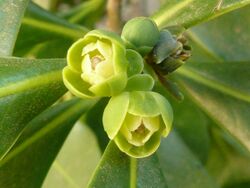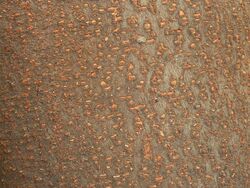Biology:Warburgia salutaris
| Warburgia salutaris | |
|---|---|

| |

| |
| Scientific classification | |
| Kingdom: | Plantae |
| Clade: | Tracheophytes |
| Clade: | Angiosperms |
| Clade: | Magnoliids |
| Order: | Canellales |
| Family: | Canellaceae |
| Genus: | Warburgia |
| Species: | W. salutaris
|
| Binomial name | |
| Warburgia salutaris (Bertol.f.) Chiov.
| |
Warburgia salutaris (pepper-bark tree, Afrikaans: Peperbasboom, Sotho: Molaka, Venda: Mulanga, Zulu: Isibaha)[2] is a species of tree in the family Canellaceae. It is found in eastern and southern African locations e.g. Botswana, Namibia, Kenya, Tanzania, Zambia, Mozambique, South Africa , Eswatini, Malawi and Zimbabwe. It is threatened by habitat loss. It is a popular medicinal plant and is overharvested in the wild, another reason for its endangerment.[3] The Pepper-bark tree is a protected tree in South Africa.[2] Various projects are investigating methods of propagation under controlled conditions with subsequent planting in the wild.[4]
This is an erect tree growing up to about ten metres in maximum height, but known to reach 20 metres at times. It has a thick canopy of aromatic, shiny green leaves. The evergreen leaf blades are lance-shaped, measuring up to 11 cm long by 3 wide. The flowers have ten yellow-green petals. They are each just under a centimeter long and are solitary or borne in small clusters of up to 3. The fruit is a berry, leathery purple or black in color when ripe, measuring up to 4 cm wide.
The leaves are used to add peppery flavoring to food and tea.[4] The bitter taste of the tree's bark and leaves is due to the presence of iridoids. The aromatic, oily, yellowish wood is used for firewood.[4]
It is attractive and makes a good shade tree.[4]
Traditional medicine
This plant is used medicinally by the Maasai people to treat malaria.[5] It is used as a snuff or smoked for respiratory complaints such as common cold and cough.[4] The bark can be purchased at markets in Tanzania,[6] and elsewhere.[7] Moreover, "Dried bark is chewed and the juice swallowed, thus acting as remedy for stomach-ache, constipation, coughs, fever, toothache, muscle pains, weak joints, and general body pains."[8]
Gallery
- habit
- foliage
- flowering branch
- cross-section of wood and bark
References
- ↑ Hilton-Taylor, C.; Scott-Shaw, R.; Burrows, J.; Hahn, N. (1998). "Warburgia salutaris". IUCN Red List of Threatened Species 1998: e.T30364A9541142. doi:10.2305/IUCN.UK.1998.RLTS.T30364A9541142.en. https://www.iucnredlist.org/species/30364/9541142. Retrieved 15 November 2021.
- ↑ 2.0 2.1 "Protected Trees". Department of Water Affairs and Forestry, Republic of South Africa. 3 May 2013. http://www2.dwaf.gov.za/dwaf/cmsdocs/4116___poster%20protected%20trees.pdf.
- ↑ "Warburgia salutaris | PlantZAfrica.com". http://www.plantzafrica.com/plantwxyz/warburg.htm.
- ↑ 4.0 4.1 4.2 4.3 4.4 W. salutaris. World Agroforestry.
- ↑ Bussmann, RW; Gilbreath, GG; Solio, J; Lutura, M; Lutuluo, R; Kunguru, K; Wood, N; Mathenge, SG (2006). "Plant use of the Maasai of Sekenani Valley, Maasai Mara, Kenya". Journal of Ethnobiology and Ethnomedicine 2: 22. doi:10.1186/1746-4269-2-22. PMID 16674830.
- ↑ "Indigenous multipurpose trees of Tanzania: Uses and economic benefits for people - WARBURGIA SALUTARIS". http://www.fao.org/docrep/x5327e/x5327e1u.htm.
- ↑ Botha, J.; Witkowski, E.T.F.; Shackleton, C.M. (2004). "The impact of commercial harvesting on Warburgia salutaris ('pepper-bark tree') in Mpumalanga, South Africa". Biodiversity and Conservation 13 (9): 1675. doi:10.1023/B:BIOC.0000029333.72945.b0..
- ↑ Kokwaro, J. O. (1993). Medicinal plants of East Africa (2nd ed.). Nairobi: Kenya Literature Bureau. ISBN 978-9966-44-190-4. OCLC 32406949. https://www.worldcat.org/oclc/32406949.
Wikidata ☰ Q142235 entry
 |


